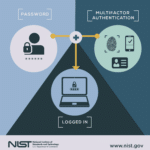Ensuring Cybersecurity Success
What KPIs keep your organization protected?
As cybersecurity threats increase and become more sophisticated, implementing a multi-layered cybersecurity strategy is one of the best ways to stay protected. Strategies such as Multi-Factor Authentication (MFA), endpoint threat detection and response tools, data back-up and recovery, and cybersecurity training allow you to strengthen your security posture, but how do you know if cybersecurity measures like these are effective?
Just as Key Performance Metrics (KPIs) are important for measuring business success, there are specific ways you can measure your cybersecurity strategy to ensure its success in meeting your overall goals. Continue reading to learn our top recommendations to ensure a successful cybersecurity defense.
Examine Your Cybersecurity Processes
Start by examining your internal cybersecurity processes. This will involve your team and the tools you use, as well as business-specific policies, procedures, and risk priorities. Outline your current processes to note any gaps or areas where improvement is needed.
It’s important to always connect these processes back to your overall business goals and objectives. The World Economic Forum stresses the importance of this in a recent article:
Cybersecurity personnel need to take the time to understand business strategy and objectives and develop a security strategy that supports these. Demonstrating a clear link between security and business goals will go a long way towards ensuring that the board and C-suite executives both understand and will be willing to approve initiatives to enhance corporate security.
The World Economic Forum:
How aligning cybersecurity with strategic objectives can protect your business
- Implement cybersecurity maturity ratings to measure your processes. The higher the score, the more "mature" or well-prepared your processes are in the event of a cybersecurity attack.
- Utilize quality data to measure performance and results in an accurate way
- Measure detection and response times to see how accurately your team, security infrastructure, and systems can both detect and respond to threats
Measure Your Technology Effectiveness
Next, take a deep dive into the technology tools your business utilizes to determine what’s working and what isn’t. Cisco put together an independent, double-blind study to survey over 5,000 IT professionals around the world. The report found the top indicators of cybersecurity success — from utilizing integrated technology tools to improving response times.
You can achieve this by deciding the right KPIs and technical measures for your business and ensuring the technology you implement supports them. As a helpful guide, we recommend reviewing Gartner’s infographic on “2022 Leadership Vision for Security and Risk Management.” It outlines the top three strategic security challenges business leaders face and recommends ways to successfully secure your organization.
Consider IT Compliance Regulations
Compliance regulations are an important part of cybersecurity. Developing a comprehensive, ongoing strategy to meet your industry’s compliance regulations involves two core components: risk assessments and vulnerability assessments. Risk assessments provide insight into risk exposure while allowing your business to prepare appropriately. Vulnerability assessments examine your existing servers, workstations, firewalls, and other IT infrastructure to find gaps and exposures.
Compliance regulations can be complex to understand and result in legal implications. It’s best to work with a managed IT services company to mitigate any risks, and AllConnected can help.
Ensure Cybersecurity Success With AllConnected
If you’re interested in discussing your cybersecurity strategy with a trusted IT professional, consider partnering with AllConnected. Our security services and IT management can ensure your IT strategy aligns with your business objectives, meets your industry’s regulatory requirements, and protects your most important assets. Contact us today to get started.




